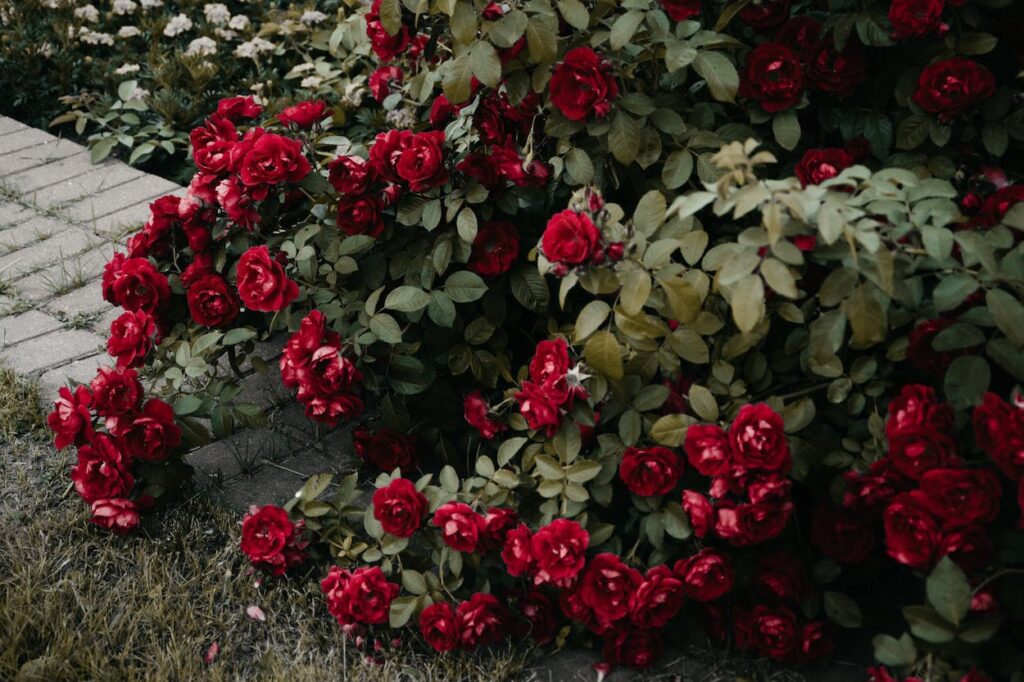For the Puslinch Pioneer, by Susan Mason. November 2020

Wild, Old Garden, Modern
I glory in my garden for all its aesthetic qualities: beautiful colours, shapes and forms, fragrant flowers and ever-present buzzing pollinators. I also wonder about the unseen stories each plant could tell- its origin, in other lands, in other times.
Our gardens tell stories in time. Above all else, the Rose is renowned in this regard. Roses have been cherished since Ancient Egyptians placed rose petals in their tombs for their afterlife.
Roses have prevailed over 35 million years because they are hardy, strong, stunning performers. Romans used them as confetti, medicine and perfume. They symbolize love, passion and the sweet-sorrow of “twixt beauty and the thorn”.
There are 3 Groups of Roses:
- Wild/ Species Roses.
- Hybridized species roses creating Old Garden Roses.
- Modern Roses (which date to 1867 when the 1st Hybrid tea recurrent rose was introduced). Shrub Roses (1940 dates the Kordes family discovery- a new species R.kordesii (extensively used in breeding programs- Canada’s Explorer series).
Hybrid teas dominated the 20th Century. Breeders produced ever larger, fuller, more colourful blooms with longer stems- excellent for cutting. Flower shops appeared in 1875 along with the florist industry. Hybrid teas became the iconic symbols of the rose. (Valentine’s Day)
But they are less hardy, formal, high-maintenance and prone to disease. New natural gardening movements formed. Busy life-styles desired hardy, easy-care roses. Species and Old Garden Roses underwent a new revival.
Here are some of my experiences in seeking hardy roses:
- Wild/Species Roses
My garden is north-facing and canopied by trees lending itself to a natural woodland style. Species roses such as Ontario natives -Rosa blanda (Smooth Rose), Rosa setigera (Prairie Rose) and European Rosa glauca (Redleaf Rose) have thrived even in shade. They give all-season interest into the fall, displaying yellow foliage and red hips.
- Modern Roses
I shied away from Hybrid teas but my garden has benefitted from hybridized roses. Hybrid rugosas such as Henry Hudson, Hansa and Snow Pavement thrive and have every attribute you could desire. David Austin roses- bred to combine Old Rose blooms and fragrance with hardiness and disease- resistance are less successful. Canadian roses always perform well. William Baffin is one of the best, hardiest climbers, successfully bred to withstand winter dieback to its 12’ canes. Magnificent!
The downside to Modern roses is that intensive breeding resulted in many having less hardiness and slight to no scent! Is a Rose a Rose if it doesn’t smell?
- Old Garden Roses
And so I return to Old Garden Roses. Although once-blooming, but lasting 4-6 weeks, they are hardy, disease-resistant with the bonus of amazing fragrance and historical significance.
Consider:
Alba: Romans to 18th c. Europe.
Alba maxima– “Jacobite Rose”- War of Roses- 15th c.
Centifolia: “100 petals” Cabbage Rose- featured in Dutch Old Master paintings.
Henri Martin– red- France-1863.
Damask: Crusaders brought to England.
Mme Hardy– white, green button eye- 1831.
Gallica: purples, reds- stripes. Monasteries-soaps, perfumes.
Apothecary– 1600.
Try something Old again!
Susan Mason
Nov. 2020.
